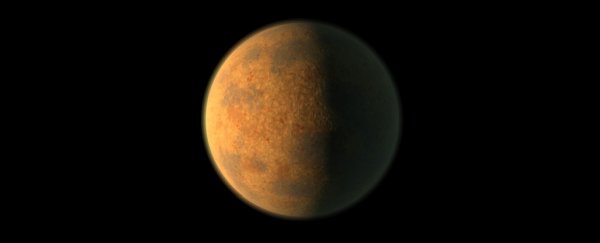The Universe is a wonderfully weird and varied place. We've barely even begun to scratch the surface of what might be possible. It would be foolish, for example, to imagine that our Solar System displays the entire gamut of planetary diversity.
In fact, we know it doesn't. But our detection technologies are not yet sophisticated enough for us to observe exoplanets (planets outside the Solar System) in particularly fine detail. According to new research, one such type of exoplanet could be like giant cosmic eggs.
These exoplanets would have a single, fused, thin and brittle lithosphere – the outermost planetary layer – with little to no topography: like an eggshell enclosing the planetary interior. Because this lithosphere is one unbroken piece, these eggshell worlds would have no plate tectonics; in turn, this could limit their habitability.
It's a finding that could add one more parameter to refine our search for habitable worlds in the Milky Way galaxy.
"Understanding whether you've got the possibility of plate tectonics is a really important thing to know about a world, because plate tectonics may be required for a large rocky planet to be habitable," says planetary geologist Paul Byrne of Washington University in St Louis.
"It's therefore especially important when we're talking about looking for Earth-like worlds around other stars and when we're characterizing planetary habitability generally."
Because we can't resolve surface details of exoplanets – at least, not yet – astronomers have found other ways to try and explore the possible range of worlds that might be out there beyond the Solar System.
This usually takes the form of simulations and modelling. We know there are certain characteristics that play a role in shaping exoplanets, such as size, age, composition, internal temperature, and distance from the host star; by varying these characteristics in a model, planetary scientists can obtain a range of possible exoplanet morphologies.
Byrne and team wanted to know which of these parameters play a role in determining the thickness of an exoplanet's lithosphere. This can reveal a suite of other characteristics, because the thickness of the lithosphere plays a role in whether that lithosphere can support mountain ranges, or whether it's flexible enough to support tectonic subduction – where the edge of one plate bends and slides below another.
Tectonic subduction plays an important role in maintaining Earth's climate, and is thus thought to be very important (although maybe not absolutely necessary) for habitability. So if we can figure out if an exoplanet does or doesn't fit the parameters for a subducting lithosphere, we can incorporate that information into our search for habitable worlds.
One of the main characteristics that we think would make an exoplanet habitable is if the world is rocky, like Earth, Mars or Venus. So the researchers started with a generic, rocky, Earth-sized world. From that point, they ran thousands of models, tweaking parameters and analyzing the results.
These results revealed how an eggshell exoplanet might form.
"Surface temperature is the dominant factor governing the thickness of the brittle layer: smaller and older planets generally have thick brittle lithospheres, akin to those of Mercury and Mars, whereas larger, younger planets have thinner brittle lithospheres that may be comparable to the Venus lowlands," the researchers wrote in their paper.
"But certain combinations of these parameters yield worlds with exceedingly thin brittle layers. We predict that such bodies have little elevated topography and limited volatile cycling and weathering."
Those exoplanets, the team determined, likely resemble the lowlands of Venus. Surface temperatures on Venus average at around 471 degrees Celsius (880 degrees Fahrenheit). These scorching temperatures mean that, in parts such as the lowlands, the Venusian lithosphere is very thin, resulting in flat, more or less featureless terrain.
The results offer future hunters of habitable worlds a framework for calculating the lithospheric thickness of exoplanets for which we know the mass, size, and surface temperature. Eggshell exoplanets ought to be super-Earths that are either very young, have radiogenic elements that heat the exoplanet from within, are close to their stars, or have a runaway greenhouse effect, like Venus.
"What we've laid out here is essentially a how-to guide, or handy manual. If you have a planet of a given size, at a given distance from its star and of a given mass, then with our results you can make some estimates for a variety of other features," Byrne said.
"Ultimately we want to help contribute to identifying the properties that make a world habitable. And not just temporarily, but habitable for a long time, because we think life probably needs a while to get going and become sustainable."
The research has been published in the Journal of Geophysical Research: Planets.
